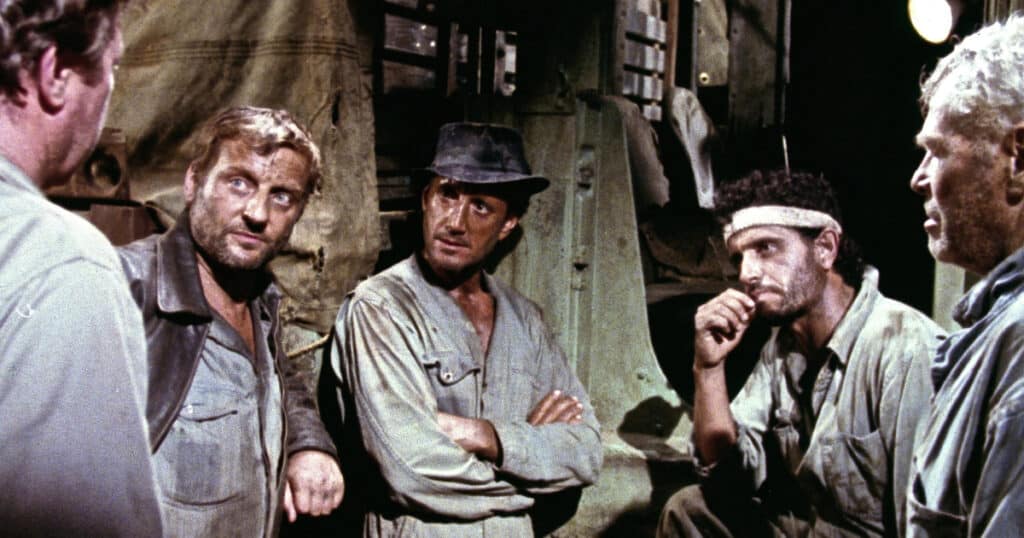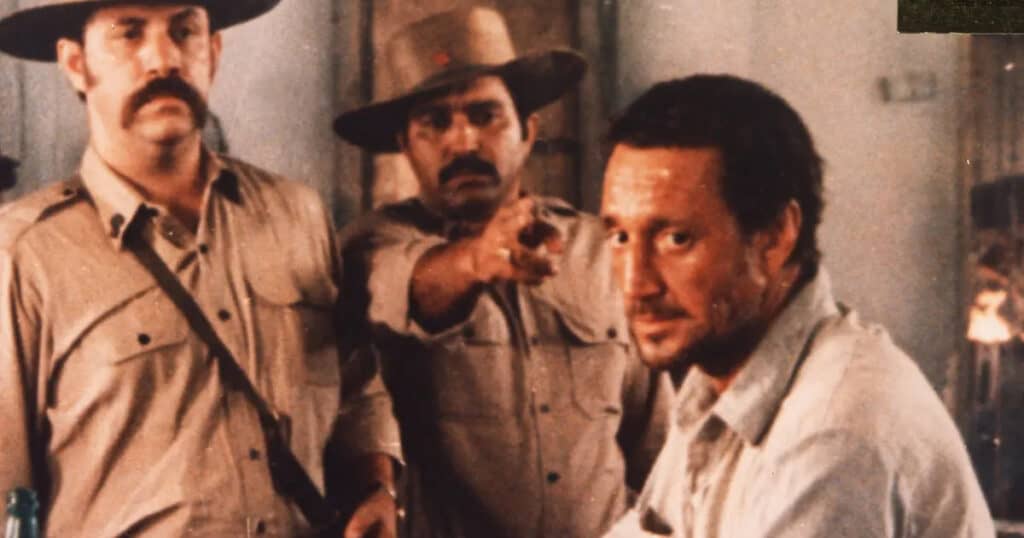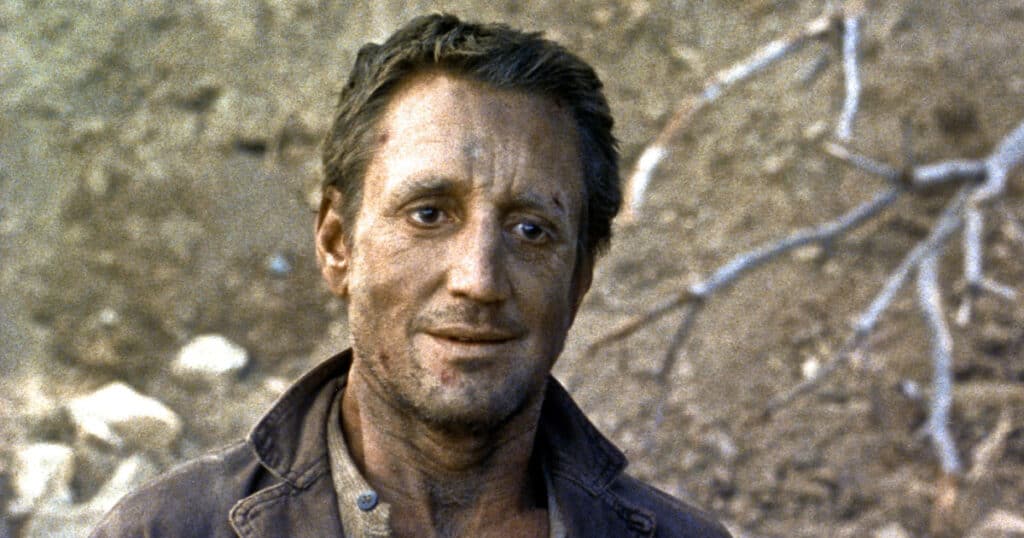The film industry is currently in mourning following the passing of acclaimed director William Friedkin, whose iconic films such as The French Connection and The Exorcist have left a profound impact on cinema. As we reflect on his profound legacy, it’s essential to revisit one of his most underrated masterpieces, the gripping action thriller from 1977, Sorcerer, which deserves a place in the spotlight.
The 1970s marked a pivotal era for filmmakers, characterized by a surge of genuine auteurs who crafted cinematic masterpieces without compromise. These directors, including legends like Martin Scorsese, Francis Ford Coppola, Steven Spielberg, George Lucas, and Brian De Palma, were responsible for shaping the landscape of cinema with films that resonate through generations. Among this illustrious group is William Friedkin, who created two iconic classics and one misunderstood gem during this era, solidifying his status in film history.
The masterpieces in question are undeniable. Within a brief span of three years, Friedkin produced The French Connection and The Exorcist, both of which are contenders for the title of Best Cop Film and Best Horror Movie ever made—feel free to share your thoughts in the comments below. The French Connection garnered Academy Awards for Best Picture and Best Director, catapulting Friedkin into the spotlight as one of the most sought-after filmmakers of his time. Meanwhile, The Exorcist achieved remarkable box office success, becoming one of the highest-grossing films in history and earning its own accolades, further elevating Friedkin’s reputation to iconic status.
Following the immense success of these critically acclaimed films, any director might feel a sense of invincibility. However, Friedkin, known for his confidence, chose to follow up with Sorcerer, intended as a modest suspense film which he believed would be a quick project before transitioning to a more ambitious venture. Yet, the universe had other plans for Friedkin, as the project evolved from a low-budget film into a daunting and costly endeavor that challenged his creative vision.
Prepare yourself for a tumultuous journey as we delve into the tumultuous production history of this film and uncover the extraordinary challenges faced by Friedkin and his team during the making of Sorcerer!
Sorcerer is adapted from the novel “The Wages of Fear” written by French author Georges Arnaud, which was previously transformed into a film in 1952 by the legendary director Henri-Georges Clouzot. Both the book and the film narrate the harrowing tale of four desperate men compelled to navigate treacherous terrain, transporting trucks laden with volatile explosives to extinguish an oil field fire. A single misstep, a significant jolt, and the nitroglycerin could ignite a catastrophic explosion—resulting in certain death for all involved. Friedkin, an admirer of both the novel and Clouzot’s film, aimed to create a darker, grittier adaptation, imbuing it with his unique cynical perspective. Although he maintained that his film was not a remake but another interpretation of the source material, he sought Clouzot’s blessing for his adaptation, which was graciously bestowed.
Initially, Friedkin envisioned his version of the film as a modest undertaking—an easy project to complete before embarking on a grand sci-fi epic titled “The Devil’s Triangle,” which would explore the mysteries of the infamous Bermuda Triangle. However, circumstances took an unexpected turn, and the ambitious “The Devil’s Triangle” was ultimately sidelined, primarily because Steven Spielberg released Close Encounters of the Third Kind, which bore striking similarities to Friedkin’s envisioned story.

After dedicating four months to meticulously crafting his script for The Wages of Fear in collaboration with Walon Green, who also contributed to The Wild Bunch, Friedkin felt prepared to create a film that would cement his legacy as a filmmaker. Traveling to the Dominican Republic, he quickly discovered that the unpredictable weather and challenging conditions would complicate matters significantly. What began as a modest budget of $2.5 million ballooned to an astounding $12 million, eventually escalating to approximately $22 million—a staggering figure for a film made in 1976, surpassing even the expenditures of Steven Spielberg on Close Encounters. The budget became so inflated that it required collaboration from two studios, Universal and Paramount, to co-produce the film.
Friedkin sought to make The Wages of Fear his own by introducing significant alterations, particularly concerning the four lead characters. Unlike Clouzot’s portrayal of them as morally upright individuals, Friedkin aimed to depict them as deeply flawed, morally ambiguous characters—one character even bluntly refers to the protagonist as “a real piece of shit.” The journey of transporting the perilous nitroglycerin becomes one of redemption, despite the film’s opening act revealing that they are indeed killers and thieves. Friedkin has consistently rejected conventional notions of heroism in film. Furthermore, Sorcerer serves as a broader metaphor for society, illustrating how individuals who may not get along must collaborate to prevent catastrophe; a theme that is both timeless and relevant.
Another significant alteration was the film’s title. Initially, one working title was “Ballbreaker,” while another was “Dynamite.” However, during his research in South America, Friedkin encountered trucks with names crudely painted on their doors. Two trucks bore the names “Sorcerer” and “Lazarus.” This inspired him to name the trucks in his film accordingly, even if the audience never clearly sees the inscriptions. Friedkin also perceived deeper meaning in the title, stating that a “sorcerer is an evil wizard, and in this context, fate acts as that evil wizard,” emphasizing the characters’ lack of control over their destinies.
For the lead role of Jackie Scanlon, a criminal from New Jersey seeking refuge in a South American village, Friedkin had envisioned the legendary Steve McQueen. McQueen expressed enthusiasm for the script, yet, having recently married Ali MacGraw, he was reluctant to leave her behind during the three-month shoot. He proposed that Friedkin create a role for MacGraw so she could accompany him to the Dominican Republic, a request that Friedkin dismissed. After McQueen’s attempts to involve her as an associate producer fell through, he ultimately withdrew from the project. Other notable names such as Clint Eastwood, Gene Hackman, and Robert Mitchum were considered, but the role ultimately went to Roy Scheider, who had previously collaborated with Friedkin on The French Connection. Although their relationship had soured somewhat over Scheider’s desire to portray Father Karras in The Exorcist, he had just come off a successful performance in Jaws, making him an appealing choice for the leading role.
The remaining three principal actors—Bruno Cremer, Amidou, and Francisco Rabal—were relatively unknown in the U.S., raising concerns among studio executives about the film’s box office potential. Despite this, Friedkin forged ahead, confident that audiences would be drawn to the film purely because of his directorial name. At one point, he even suggested that the studio should Americanize the actors’ names for release, but this idea never materialized.
To authentically depict the film’s remote Colombian setting, most of Sorcerer was filmed amidst the dense jungles of the Dominican Republic, where the crew faced the daunting task of constructing their own roads for the truck-driving sequences. The conditions were sweltering and uncomfortable, leading to numerous illnesses among the cast and crew, including Friedkin, who suffered from malaria and dysentery. Some crew members were sent back to the United States due to suspicions of drug use, which local authorities would not tolerate, prompting them to flee back to their homes to avoid incarceration.

Amidst the chaos of sickness and potential legal troubles, crew members faced the constant threat of being dismissed. Known for his fiery temperament, earning him the nickname “Hurricane Billy,” Friedkin displayed authoritarian tendencies during filming, frequently firing individuals, including production managers, teamsters, and stunt personnel, as well as long-standing collaborators. His original cinematographer, Dick Bush, was replaced mid-production due to Friedkin’s dissatisfaction with his work. Tensions also arose between Friedkin and Roy Scheider, despite their previous camaraderie during The French Connection. Scheider later quipped that he was the only person Friedkin could not dismiss due to his leading role, contrasting it to the tumultuous production of Jaws, which he described as a walk in the park compared to the struggles faced on Sorcerer.
Significant challenges arose during the filming of the film’s most thrilling sequences, particularly when the nitroglycerin-laden trucks needed to traverse a precarious rope bridge over a turbulent river. The initial river selected in the Dominican Republic was deemed unsuitable due to an extreme drought, prompting the production to relocate to Mexico, where they discovered a suitably intimidating river. However, as the bridge was being constructed, the water level began to recede, resulting in a nearly dry riverbed. Was the production cursed? To overcome this challenge, Friedkin resorted to artificially filling the river with thousands of gallons of water, employing rain machines and hoses to simulate a torrential storm. To create the illusion of the bridge’s instability, hydraulic mechanisms were placed beneath it, and the trucks were often tethered to the bridge to prevent them from toppling off. Despite these precautions, numerous trucks fell into the river during filming, including one incident where Friedkin was inside the cab. Remarkably, the actors were often driving the trucks themselves, and no one sustained serious injuries. The two dramatic bridge scenes, each lasting roughly 12 minutes, consumed several months to shoot and collectively incurred around $3 million of the film’s spiraling budget.
Another pivotal moment in the film occurs when the trucks encounter a massive fallen tree obstructing their path, necessitating the use of some nitroglycerin to detonate it. The production faced a significant hurdle when it became apparent they lacked sufficient explosives for the task. In a bold move, Friedkin enlisted the help of a dubious associate from New York, known as “Marvin the Torch,” a former arsonist who specialized in blowing up buildings for insurance schemes. Although he claimed to be retired from such activities, he flew to the Dominican Republic with suitcases filled with “beauty supplies.” Ultimately, Marvin successfully detonated the tree, resulting in a spectacular explosion, and promptly returned to New York shortly thereafter.

After the exhausting ten-month filming process concluded, the editing phase began, which Friedkin claims proceeded relatively smoothly. However, the studios remained apprehensive, uncertain if they had just squandered over $20 million on a potential flop. After executives from Universal viewed an early cut, they summoned Friedkin for a meeting to discuss the film’s future. In a comedic twist, Friedkin arrived with writer Walon Green and editor Bud Smith, instructing them to remain impassive while the executives reviewed their notes, forbidding them from nodding or agreeing with any of their comments. Friedkin himself ordered a bottle of vodka and began drinking straight from it during the meeting, eventually collapsing on the floor in a dramatic display. The intention was to bewilder the studio executives to the point of leaving them alone, which succeeded. Friedkin retained final cut on Sorcerer and was determined to craft the cinematic vision he had envisioned.
For the film’s score, Friedkin turned to the innovative German electronic group Tangerine Dream, whose music had captivated him during a concert in Germany years prior. He proposed that they create a score solely based on the script of Sorcerer. Remarkably, they completed the score and sent the tapes while Friedkin was still in the midst of filming. In an unconventional creative decision, Friedkin and his editor ultimately edited the film to synchronize with the haunting and surreal score provided by Tangerine Dream.
Upon its release in theaters in June 1977, Sorcerer was accompanied by significant promotional efforts from the studios. However, it became evident almost immediately that Friedkin’s ambitious endeavor was faltering. Critics offered harsh reviews, and box office returns were even grimmer. The summer of 1977 was dominated by the release of Star Wars, which premiered just a month earlier and was rapidly becoming a cultural sensation. Audiences gravitated towards the dazzling space adventure crafted by George Lucas, preferring to immerse themselves in a galaxy far, far away rather than endure the tense atmosphere of a truck filled with nitroglycerin and characters who barely spoke. As moviegoers flocked to witness the epic battle against the oppressive Empire, Friedkin’s grim tale of desperate criminals went largely unnoticed.

Some speculate that the title may have contributed to its struggles: a film titled Sorcerer from the director of The Exorcist led many to anticipate a supernatural narrative, and when they realized that was not the case, audiences lost interest. Additionally, the absence of well-known actors in the cast likely deterred potential viewers. Whatever the reasons, Sorcerer faced a harsh theatrical reception, even failing to compete with Exorcist II: The Heretic, an inferior sequel to Friedkin’s own blockbuster. Ultimately, Sorcerer grossed a mere $9 million that summer and was quickly displaced from theaters that sought to make room for Star Wars, which ironically cost roughly half of Sorcerer’s budget. An article by Money Into Light discusses how the film was severely edited for international release and also retitled The Wages of Fear.
The financial disappointment led to Friedkin retreating to France, where he reflected on the experience and the factors that contributed to his film’s failure. After enjoying a period of acclaim and recognition, Friedkin faced a harsh reality check, understanding that many were likely pleased to see his fall from grace. While he has produced notable works in subsequent years, such as To Live and Die in L.A. and Killer Joe, the aftermath of Sorcerer significantly impacted his career trajectory.
In the years following its initial theatrical release, Sorcerer has undergone a remarkable reevaluation, as contemporary audiences have come to appreciate its suspenseful, unsettling, and masterfully crafted narrative. Friedkin has openly stated that it’s the film he is most proud of, and it certainly posed one of the most significant challenges in his career. Renowned figures like Stephen King and Quentin Tarantino have hailed it as one of the greatest films ever made, and it continues to be rediscovered by new generations. When viewed alongside The French Connection and The Exorcist, Sorcerer completes a triumvirate of films from a director at the zenith of his creative prowess. Fittingly, the arduous process of creating Sorcerer mirrored the turbulent journey depicted in the film itself, and perhaps even more fittingly, it was initially overlooked despite its remarkable achievements. Today, it stands recognized as a true cinematic gem; perhaps this was its destined path all along.

[nospin]Here you can find the original article; the photos and images used in our article also come from this source. We are not their authors; they have been used solely for informational purposes with proper attribution to their original source.[/nospin]





